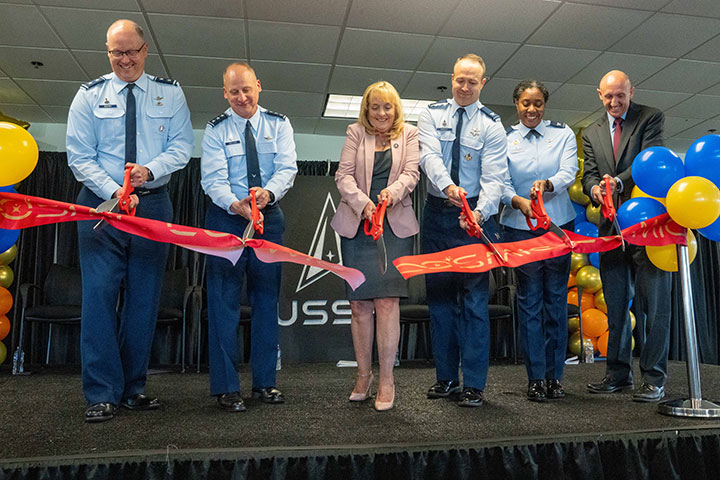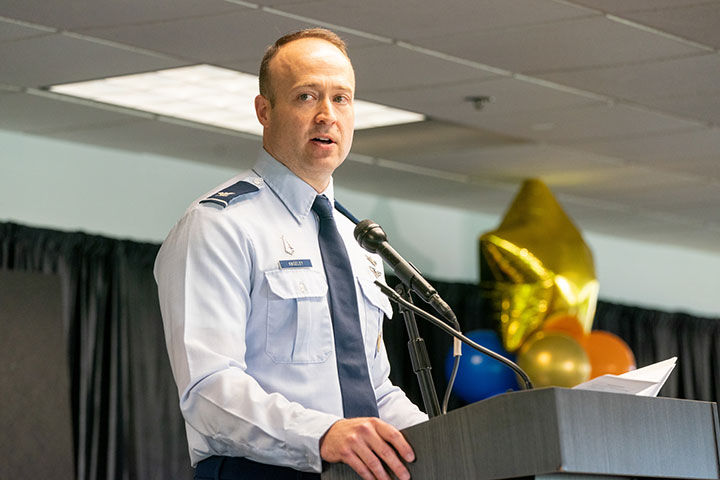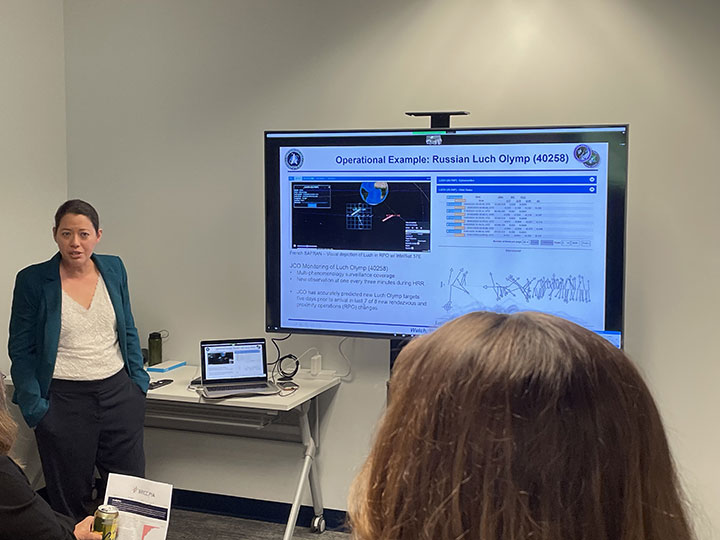CHANTILLY, Va. — More than 200 members of industry, civil and military space attended the opening of the Commercial Space Marketplace for Innovation and Collaboration (COSMIC) in Chantilly, Virginia, a 10,000 square-foot facility that will serve as the headquarters for Commercial Space Office (COMSO).
 (Left to right) Maj. Gen. Steve Whitney of the Air Force for Space Acquisition and Integration, Lt. Gen. Michael Guetlein head of Space Systems Command, Joy White, Space Systems Command, executive director, Col. Richard Knisely, senior materiel leader for COMSO, Col. Janelle Jackson of the AFRL and John Forte, CEO and President of the Virginia Tech Applied Research Corporation lead the ribbon cutting for COSMIC, June 6, 2023, in Chantilla, Va. (Source: U.S. Air Force/Cherie Cullen)
(Left to right) Maj. Gen. Steve Whitney of the Air Force for Space Acquisition and Integration, Lt. Gen. Michael Guetlein head of Space Systems Command, Joy White, Space Systems Command, executive director, Col. Richard Knisely, senior materiel leader for COMSO, Col. Janelle Jackson of the AFRL and John Forte, CEO and President of the Virginia Tech Applied Research Corporation lead the ribbon cutting for COSMIC, June 6, 2023, in Chantilla, Va. (Source: U.S. Air Force/Cherie Cullen)
COSMIC was designed as a physical space for collaboration across agencies and, if successful, a bridge across the so-called valley of death, where technology innovations often fail to make it from funded development to deployment.
“As a startup, dealing with the Space Force, Space Systems Command is kind of daunting,” said Alessandro Stabile, founder and CEO of Magma Space, a company specializing in novel magnetic-bearing technology to enhance precision satellite applications by reducing the “jitter” caused by micro-vibration.
Stabile hopes COSMIC fulfills its goal of connecting innovators with military buyers who can help fund further development and ultimately deploy new technology. “Survival is your main risk,” he told Constellations. “We’re hoping that with Space Systems Command, with this office, there will be more opportunity for someone like us to get in front of the right people and convince them we have something.”
COMSO was created in April under the auspices of Space Systems Command (SSC) as a single point to conduct outreach to the commercial space community. It’s an umbrella organization that encompasses of SPACEWERX, the SSC Front Door initiative, the Commercial Satellite Communications Office, the commercial SDA marketplace and the recently created surveillance, reconnaissance and tracking (SRT) marketplace.
Space Force has been under pressure from lawmakers and some senior leaders to leverage the rapidly advancing commercial space ecosystem space innovation in their acquisition strategy. The ribbon cutting on June 6 suggests a step forward toward buying more commercial capabilities.
“Historically, Space Force has been talking a lot about their strategy for commercial but we haven’t seen a huge amount of boots-on-the-ground activity,” former NGA Director of Commercial Operations and current Chief Strategy Officer at GXO Inc. David Gauthier told Constellations. “COSMIC itself really represents a shift from just talking strategy to actually implementing it with partners in the ecosystem.”
COMSO Funding by FY 2025
While the opening of COSMIC represents a promising step, there is currently no “dedicated funding line” for the Commercial Space Office. The office has a working capital fund of $167 million focused primarily on COMSATCOM that will be available for use by October 2024.
 Col. Richard Kniseley addresses an audience of industry and government attendees at the grand opening of the COSMIC facility in Chantilly, Va. On June 6, 2023. (Source: U.S. Air Force/Cherie Cullen)
Col. Richard Kniseley addresses an audience of industry and government attendees at the grand opening of the COSMIC facility in Chantilly, Va. On June 6, 2023. (Source: U.S. Air Force/Cherie Cullen)
Col. Richard Knisely, the senior material leader for COMSO, told reporters that he will work with Congress to establish a dedicated budget line for commercial space in the FY 2024 budget. That new line item would be funded in FY 2025 at the earliest.
Funds will continue to be available through other COMSO offices, like SPACEWERX and JTF-SD. In the meantime, SSC has an opportunity to use the time to project a roadmap with the types of investments or R&D it will need when the budget comes online, Gauthier suggested.
“If COSMIC can do one great thing right now, it would be to forecast where they’re going to be in 2-3 years, so industry can help get there and be ready when the money appears,” he said.
Chris Taylor, CEO and co-founder of Aalyria, an advanced networking firm, agreed that both industry and government could benefit from a clearer roadmap. “I think industry needs to better understand exactly what government needs and wants and where they’re going,” he told Constellations, adding that COSMIC will provide a place to improve that understanding.
In the coming months, SSC and COMSO will release frameworks detailing areas where industry can contribute to the mission. Kniseley and SSC Commander Lt. Gen. Michael Guetlein anticipate COMSO marketplaces will expand beyond SDA and SRT, to other areas that lend themselves to commercial innovation, such as weather, alternative position, navigation and timing (PNT), data analytics and possibly infrared sensors.
“My vision with these marketplaces is to have a group of vetted vendors and capabilities and to put requirements out to them,” Kniseley told reporters.
COMSO also plans to release a framework for the Commercial Augmentation Space Reserve (CASR) by late summer. CASR is envisioned as a peacetime initiative to develop commercial space capacity that can be surged during a period of crisis or conflict.
Guetlein noted that the Commercial Satcom Office will serve as a model for future Space Force needs, so combatant commanders can request commercial capabilities “by the drink” across mission areas.
Currently, the Commercial Satcom Office spends more than $850 million annually on COMSATCOM services. In total, Guetlein estimated roughly $4 billion per year is spent on commercial space across multiple acquisition offices.
Avoiding Past Mistakes
The new COMSO office hopes to avoid some of the pitfalls of previous industry partnerships, particularly the Joint Task Force-Space Defense Commercial Operations (JCO) cell under Space Command. JCO’s space domain awareness marketplace became notorious among SDA vendors for short, unreliable two-month contracts and a tendency to buy low-value data and services, instead of platforms or more robust solutions.
In response to industry concerns, COMSO will likely extend SDA marketplace contracts to six months. Kniseley noted the contract period “may be the sweet spot to help industry out while also maintaining the attitudes [of collaboration among vendors] that we want on the ops floor.”
 U.S. Space Force Strategic Advisor for Space Domain Awareness Barbara Golf leads a demonstration of commercial data capabilities at the opening of COMSO headquarters, June 6, 2023. (Source: Constellations)
U.S. Space Force Strategic Advisor for Space Domain Awareness Barbara Golf leads a demonstration of commercial data capabilities at the opening of COMSO headquarters, June 6, 2023. (Source: Constellations)
Additionally, COMSO will be most interested in purchasing “commercial operational planning products” and platforms for data fusion and analytics, as opposed to services and raw data. In general, the office will not buy commercial imagery, but will rely on the National Reconnaissance Office (NRO), which has been actively awarding commercial remote sensing contracts.
“We’re not trying to duplicate data there,” Kniseley said of commercial satellite imagery. “What I’m more keen on are the platforms…that take the data and synthesize the data and do the tracking piece.”
Bridging Multiple Valleys of Death
COMSO will also leverage a partnership with the Virginia Tech Applied Research Corporation (VT-ARC), a university-affiliated nonprofit, that will act as an intermediary between SSC and industry. VT-ARC will assist with market research, analysis of industry capabilities and military needs, with a special focus on technology transfer and transition.
Currently, there are multiple avenues for industry to get research and or study contracts or participate in technology incubators and accelerators. But there is still a significant gap in funding the transition of technology into the adoption phase.
“In today’s innovation environment there are actually multiple valleys of death,” said VT-ARC President and CEO John Forte.
Each step along the path from concept inception to development and acquisition then integration and eventually adoption has its own “bridging challenge,” he continued. “Through places like COSMIC, we hope to more specifically focus on ways to contribute and continuously [bridge] these gaps.”
In line with the COMSO office, SSC plans to stand up at least two new innovation hubs that will be similar to the Tools Applications and Processing (TAP) lab in Boulder, Colorado, where innovators can access OPIR data in an open environment to develop new applications and novel products.
Guetlein announced SSC will open a space domain awareness lab in Colorado Springs and a surveillance, reconnaissance and tracking lab, that will be connected to an artificial intelligence accelerator. The labs will be a “sandbox” for developers to test algorithms and develop relevant applications, with a potential pathway for those tools to be incorporated into operations.
Explore More:
Podcast: Intentional Collaboration, Asking the Right Questions and Turning the Ship Around
DoD’s Space Domain Awareness Dilemma
The Complicated History of US Commercial SAR
Space Systems Command Talks about Opening the ‘Front Door’ to Industry Innovation
